Strategic Analysis: Customer Integration at Delta/Signal Corp
VerifiedAdded on 2023/06/04
|7
|830
|52
Report
AI Summary
This report analyzes the customer integration strategies of Delta/Signal Corp, an automotive electrical supplier facing declining revenues and market share. The report utilizes the Business Systems Model, examining the company's resource base, activity system, and product offerings. Appendices provide detailed analyses of industry drivers using Porter's Five Forces and SWOT analysis, along with a balanced scorecard analysis. The findings highlight financial weaknesses, including increasing costs and intense competition. The report recommends strategies to improve revenue, capture market share, and enhance customer relationships. The analysis demonstrates a strategic approach to addressing the challenges faced by Delta/Signal Corp, providing insights into its current performance, issues, and potential future options.
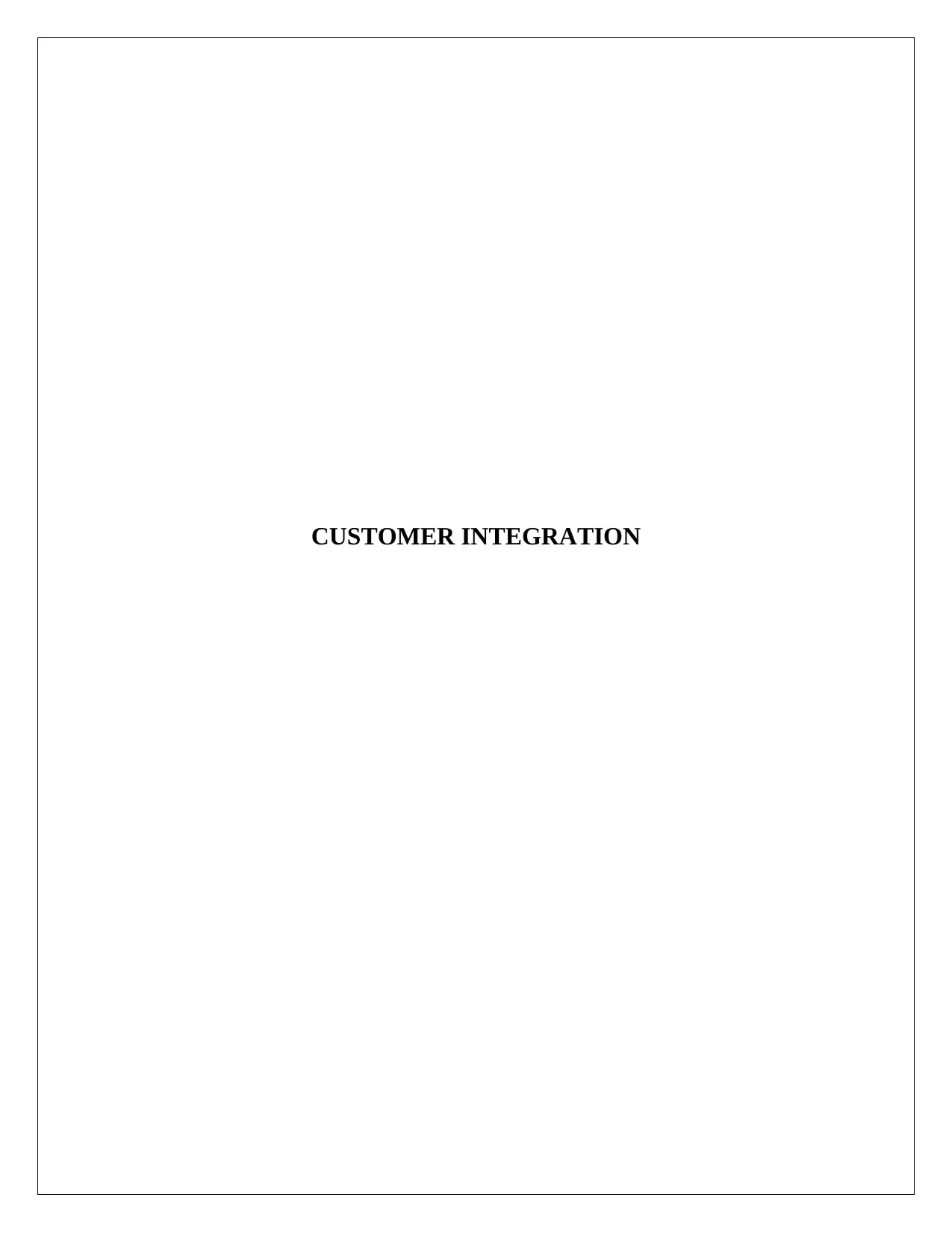
CUSTOMER INTEGRATION
Paraphrase This Document
Need a fresh take? Get an instant paraphrase of this document with our AI Paraphraser
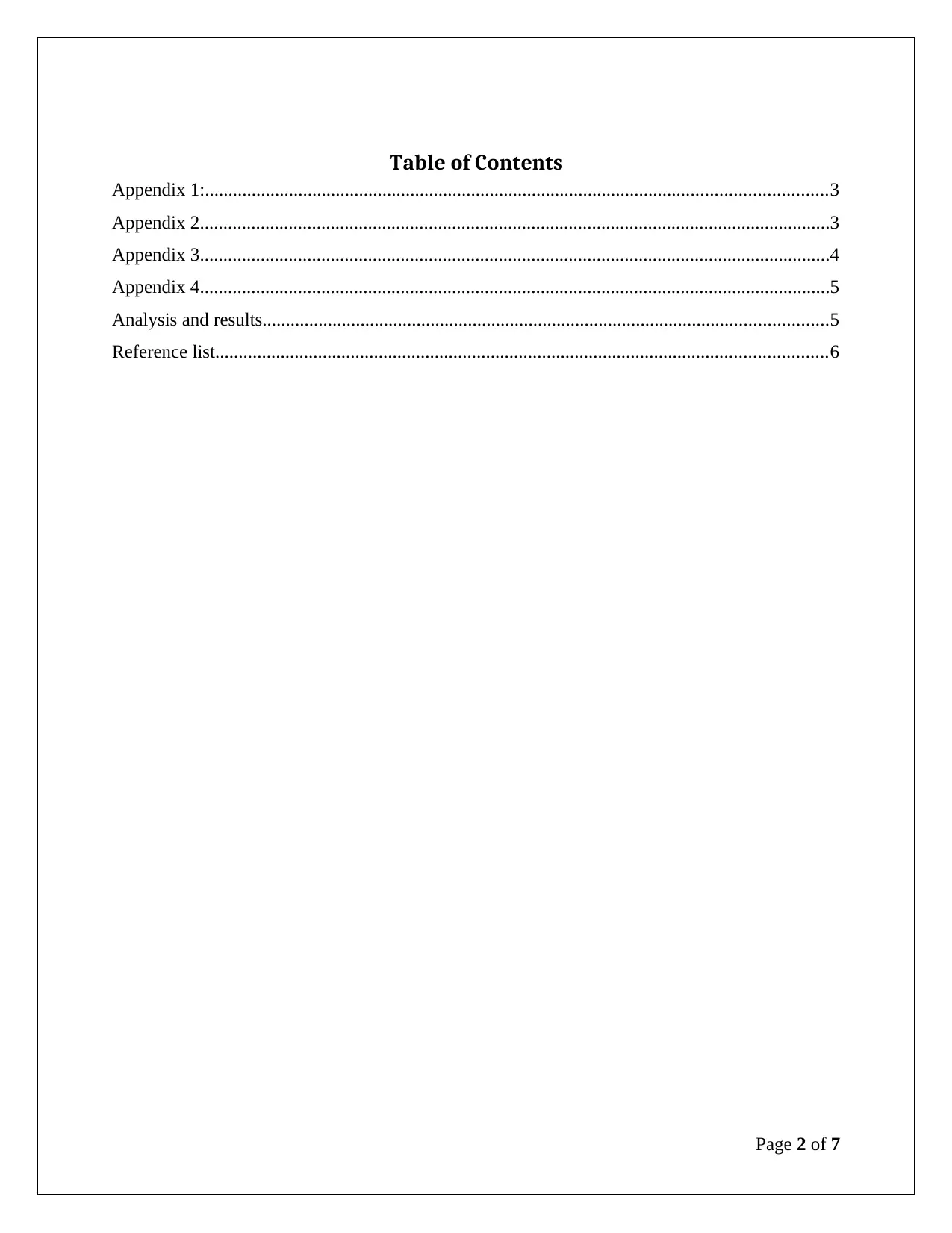
Table of Contents
Appendix 1:.....................................................................................................................................3
Appendix 2.......................................................................................................................................3
Appendix 3.......................................................................................................................................4
Appendix 4.......................................................................................................................................5
Analysis and results.........................................................................................................................5
Reference list...................................................................................................................................6
Page 2 of 7
Appendix 1:.....................................................................................................................................3
Appendix 2.......................................................................................................................................3
Appendix 3.......................................................................................................................................4
Appendix 4.......................................................................................................................................5
Analysis and results.........................................................................................................................5
Reference list...................................................................................................................................6
Page 2 of 7
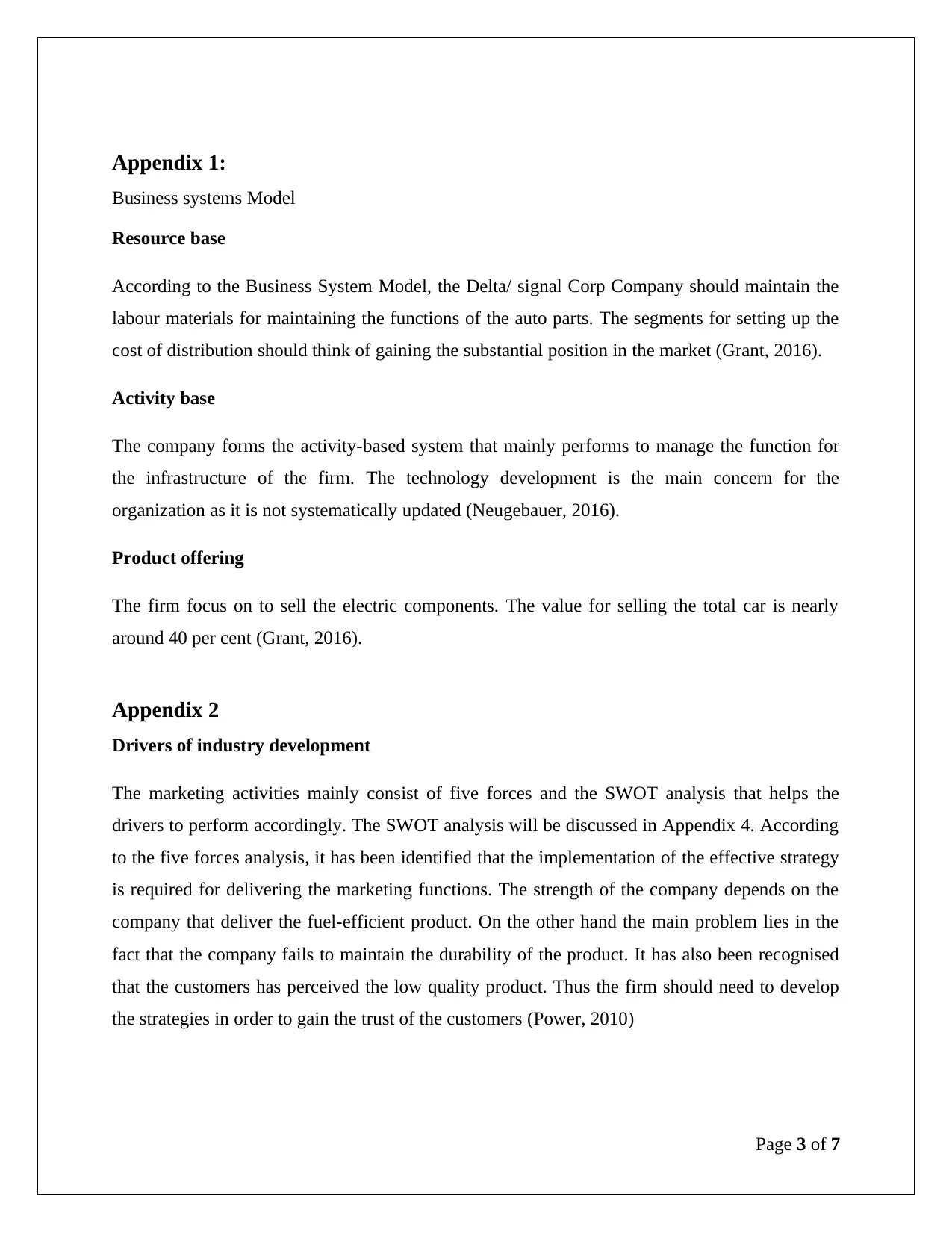
Appendix 1:
Business systems Model
Resource base
According to the Business System Model, the Delta/ signal Corp Company should maintain the
labour materials for maintaining the functions of the auto parts. The segments for setting up the
cost of distribution should think of gaining the substantial position in the market (Grant, 2016).
Activity base
The company forms the activity-based system that mainly performs to manage the function for
the infrastructure of the firm. The technology development is the main concern for the
organization as it is not systematically updated (Neugebauer, 2016).
Product offering
The firm focus on to sell the electric components. The value for selling the total car is nearly
around 40 per cent (Grant, 2016).
Appendix 2
Drivers of industry development
The marketing activities mainly consist of five forces and the SWOT analysis that helps the
drivers to perform accordingly. The SWOT analysis will be discussed in Appendix 4. According
to the five forces analysis, it has been identified that the implementation of the effective strategy
is required for delivering the marketing functions. The strength of the company depends on the
company that deliver the fuel-efficient product. On the other hand the main problem lies in the
fact that the company fails to maintain the durability of the product. It has also been recognised
that the customers has perceived the low quality product. Thus the firm should need to develop
the strategies in order to gain the trust of the customers (Power, 2010)
Page 3 of 7
Business systems Model
Resource base
According to the Business System Model, the Delta/ signal Corp Company should maintain the
labour materials for maintaining the functions of the auto parts. The segments for setting up the
cost of distribution should think of gaining the substantial position in the market (Grant, 2016).
Activity base
The company forms the activity-based system that mainly performs to manage the function for
the infrastructure of the firm. The technology development is the main concern for the
organization as it is not systematically updated (Neugebauer, 2016).
Product offering
The firm focus on to sell the electric components. The value for selling the total car is nearly
around 40 per cent (Grant, 2016).
Appendix 2
Drivers of industry development
The marketing activities mainly consist of five forces and the SWOT analysis that helps the
drivers to perform accordingly. The SWOT analysis will be discussed in Appendix 4. According
to the five forces analysis, it has been identified that the implementation of the effective strategy
is required for delivering the marketing functions. The strength of the company depends on the
company that deliver the fuel-efficient product. On the other hand the main problem lies in the
fact that the company fails to maintain the durability of the product. It has also been recognised
that the customers has perceived the low quality product. Thus the firm should need to develop
the strategies in order to gain the trust of the customers (Power, 2010)
Page 3 of 7
⊘ This is a preview!⊘
Do you want full access?
Subscribe today to unlock all pages.

Trusted by 1+ million students worldwide
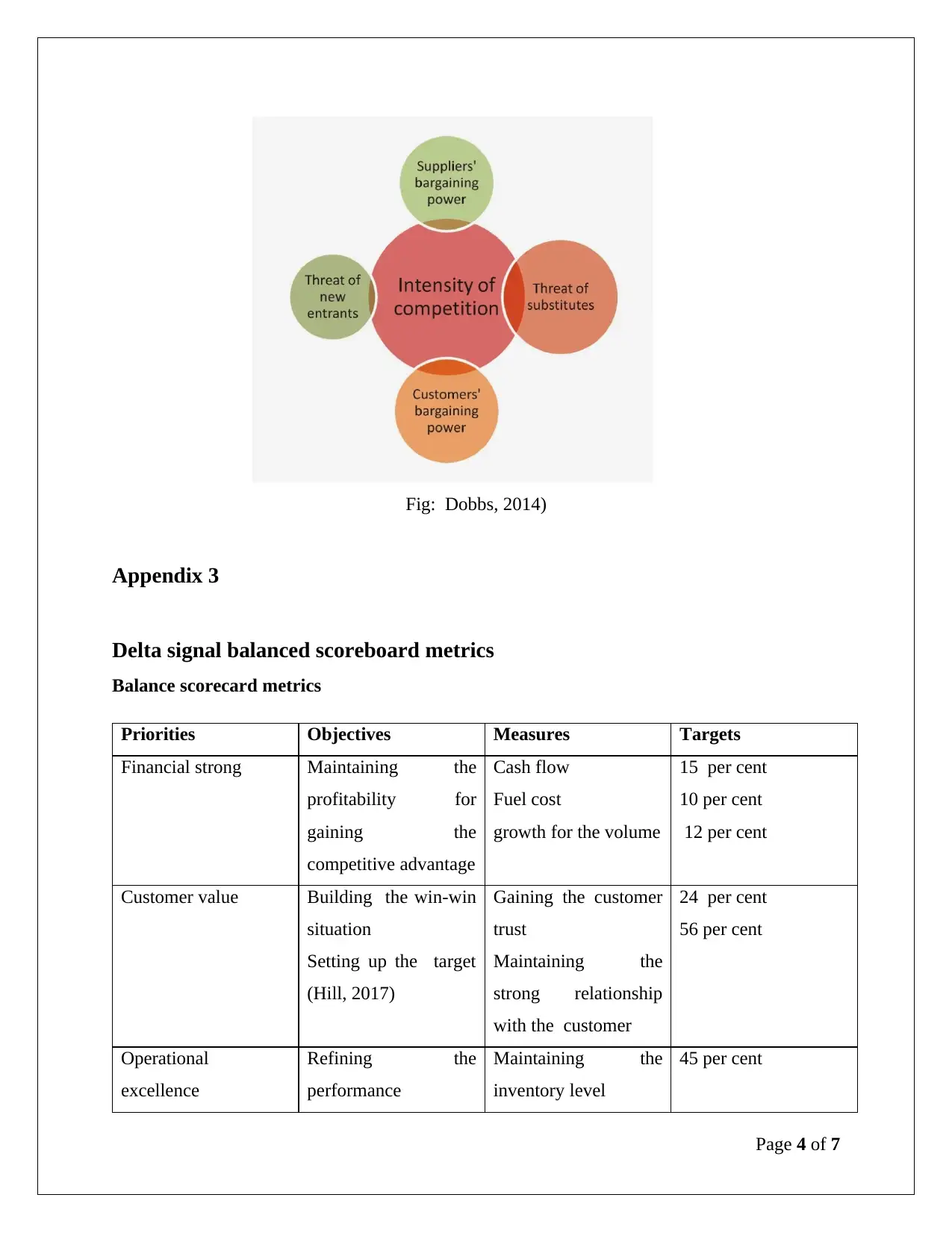
Fig: Dobbs, 2014)
Appendix 3
Delta signal balanced scoreboard metrics
Balance scorecard metrics
Priorities Objectives Measures Targets
Financial strong Maintaining the
profitability for
gaining the
competitive advantage
Cash flow
Fuel cost
growth for the volume
15 per cent
10 per cent
12 per cent
Customer value Building the win-win
situation
Setting up the target
(Hill, 2017)
Gaining the customer
trust
Maintaining the
strong relationship
with the customer
24 per cent
56 per cent
Operational
excellence
Refining the
performance
Maintaining the
inventory level
45 per cent
Page 4 of 7
Appendix 3
Delta signal balanced scoreboard metrics
Balance scorecard metrics
Priorities Objectives Measures Targets
Financial strong Maintaining the
profitability for
gaining the
competitive advantage
Cash flow
Fuel cost
growth for the volume
15 per cent
10 per cent
12 per cent
Customer value Building the win-win
situation
Setting up the target
(Hill, 2017)
Gaining the customer
trust
Maintaining the
strong relationship
with the customer
24 per cent
56 per cent
Operational
excellence
Refining the
performance
Maintaining the
inventory level
45 per cent
Page 4 of 7
Paraphrase This Document
Need a fresh take? Get an instant paraphrase of this document with our AI Paraphraser
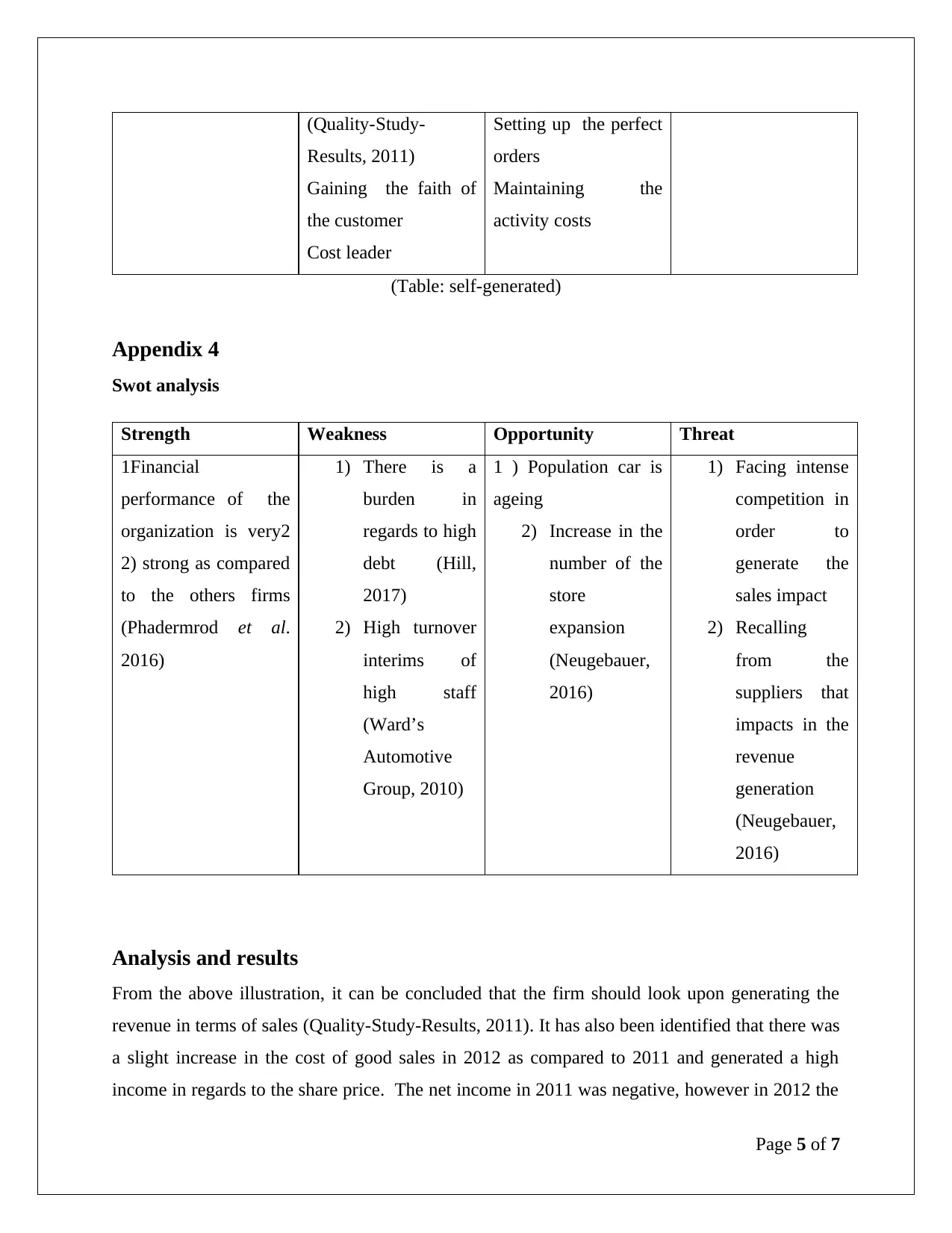
(Quality-Study-
Results, 2011)
Gaining the faith of
the customer
Cost leader
Setting up the perfect
orders
Maintaining the
activity costs
(Table: self-generated)
Appendix 4
Swot analysis
Strength Weakness Opportunity Threat
1Financial
performance of the
organization is very2
2) strong as compared
to the others firms
(Phadermrod et al.
2016)
1) There is a
burden in
regards to high
debt (Hill,
2017)
2) High turnover
interims of
high staff
(Ward’s
Automotive
Group, 2010)
1 ) Population car is
ageing
2) Increase in the
number of the
store
expansion
(Neugebauer,
2016)
1) Facing intense
competition in
order to
generate the
sales impact
2) Recalling
from the
suppliers that
impacts in the
revenue
generation
(Neugebauer,
2016)
Analysis and results
From the above illustration, it can be concluded that the firm should look upon generating the
revenue in terms of sales (Quality-Study-Results, 2011). It has also been identified that there was
a slight increase in the cost of good sales in 2012 as compared to 2011 and generated a high
income in regards to the share price. The net income in 2011 was negative, however in 2012 the
Page 5 of 7
Results, 2011)
Gaining the faith of
the customer
Cost leader
Setting up the perfect
orders
Maintaining the
activity costs
(Table: self-generated)
Appendix 4
Swot analysis
Strength Weakness Opportunity Threat
1Financial
performance of the
organization is very2
2) strong as compared
to the others firms
(Phadermrod et al.
2016)
1) There is a
burden in
regards to high
debt (Hill,
2017)
2) High turnover
interims of
high staff
(Ward’s
Automotive
Group, 2010)
1 ) Population car is
ageing
2) Increase in the
number of the
store
expansion
(Neugebauer,
2016)
1) Facing intense
competition in
order to
generate the
sales impact
2) Recalling
from the
suppliers that
impacts in the
revenue
generation
(Neugebauer,
2016)
Analysis and results
From the above illustration, it can be concluded that the firm should look upon generating the
revenue in terms of sales (Quality-Study-Results, 2011). It has also been identified that there was
a slight increase in the cost of good sales in 2012 as compared to 2011 and generated a high
income in regards to the share price. The net income in 2011 was negative, however in 2012 the
Page 5 of 7
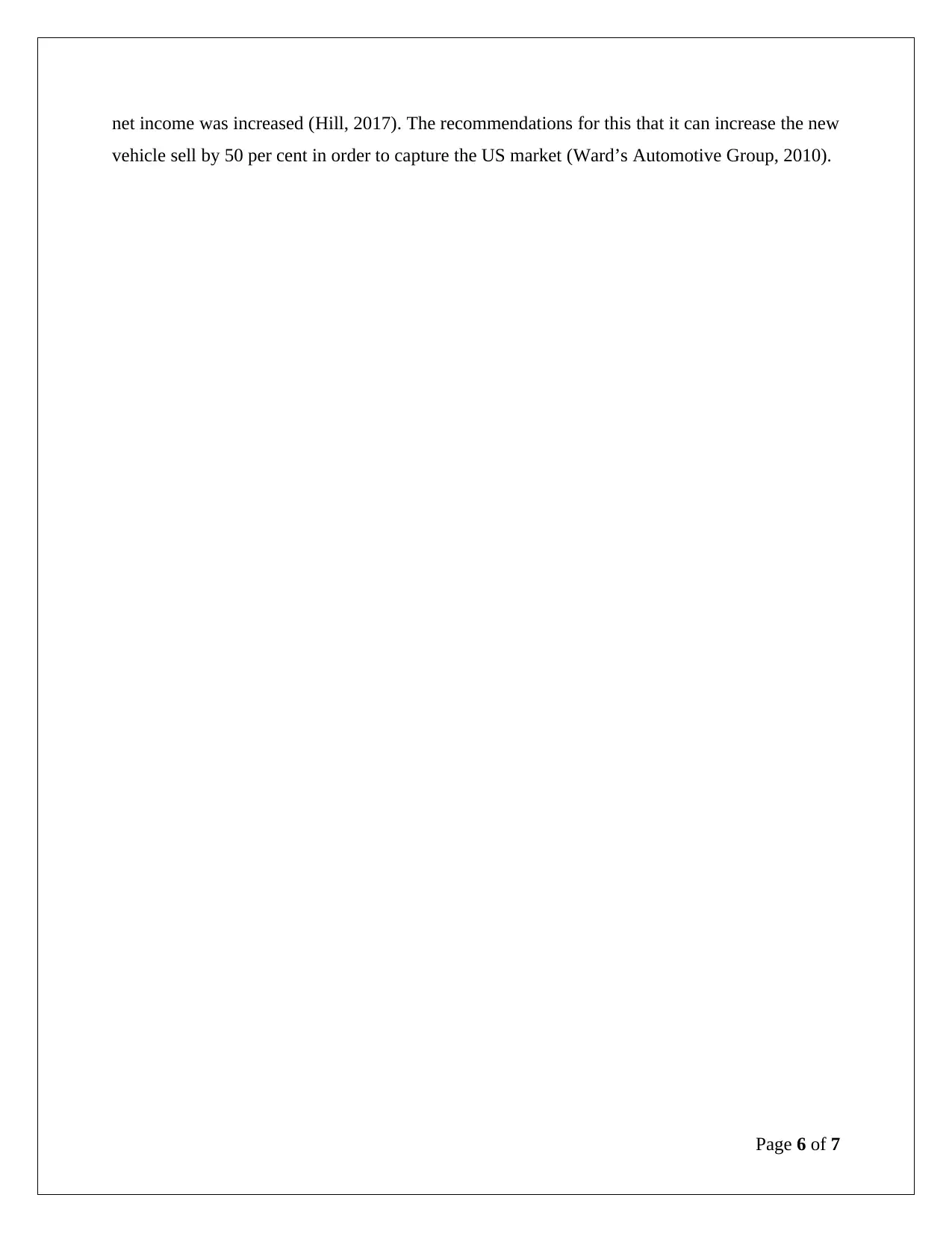
net income was increased (Hill, 2017). The recommendations for this that it can increase the new
vehicle sell by 50 per cent in order to capture the US market (Ward’s Automotive Group, 2010).
Page 6 of 7
vehicle sell by 50 per cent in order to capture the US market (Ward’s Automotive Group, 2010).
Page 6 of 7
⊘ This is a preview!⊘
Do you want full access?
Subscribe today to unlock all pages.

Trusted by 1+ million students worldwide
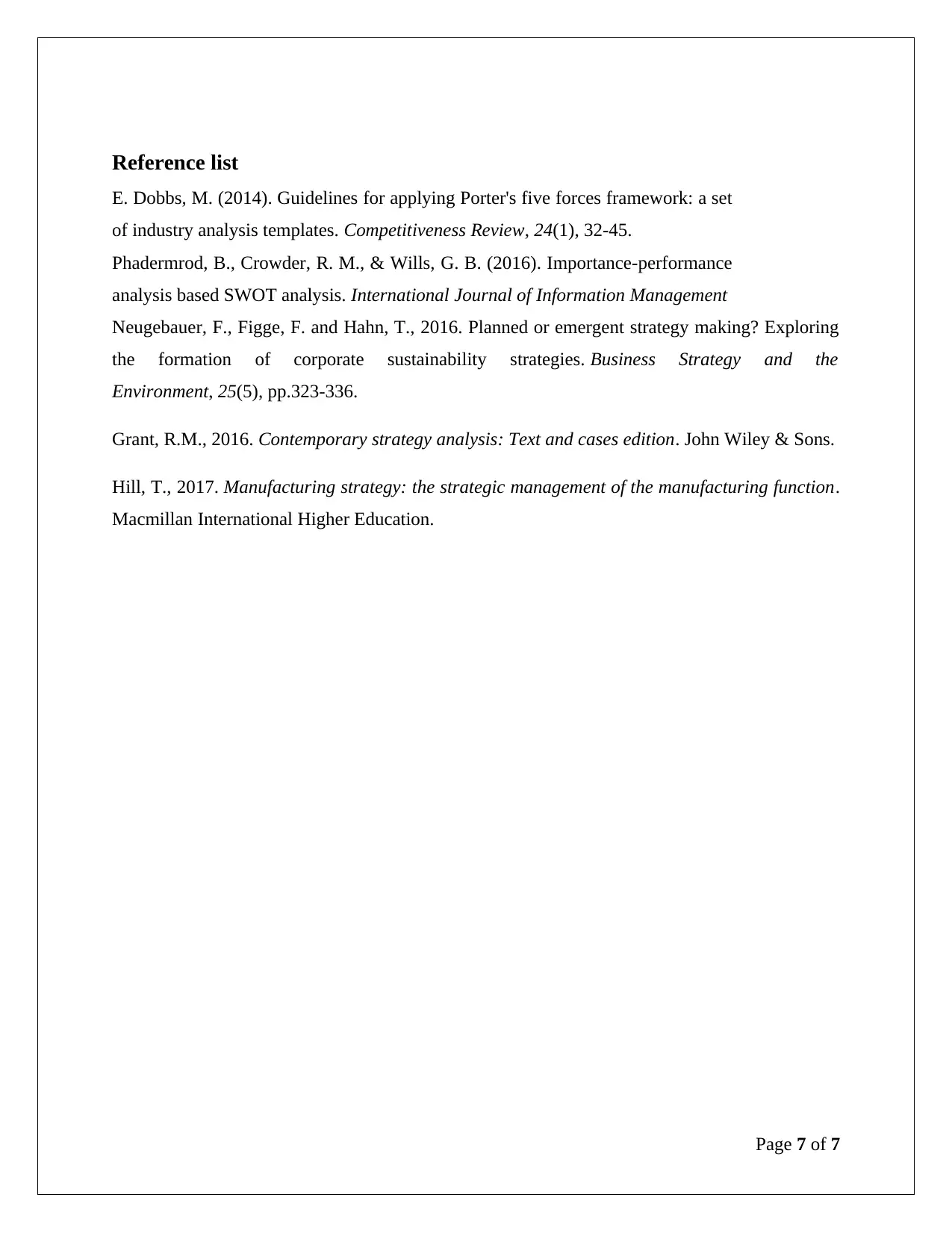
Reference list
E. Dobbs, M. (2014). Guidelines for applying Porter's five forces framework: a set
of industry analysis templates. Competitiveness Review, 24(1), 32-45.
Phadermrod, B., Crowder, R. M., & Wills, G. B. (2016). Importance-performance
analysis based SWOT analysis. International Journal of Information Management
Neugebauer, F., Figge, F. and Hahn, T., 2016. Planned or emergent strategy making? Exploring
the formation of corporate sustainability strategies. Business Strategy and the
Environment, 25(5), pp.323-336.
Grant, R.M., 2016. Contemporary strategy analysis: Text and cases edition. John Wiley & Sons.
Hill, T., 2017. Manufacturing strategy: the strategic management of the manufacturing function.
Macmillan International Higher Education.
Page 7 of 7
E. Dobbs, M. (2014). Guidelines for applying Porter's five forces framework: a set
of industry analysis templates. Competitiveness Review, 24(1), 32-45.
Phadermrod, B., Crowder, R. M., & Wills, G. B. (2016). Importance-performance
analysis based SWOT analysis. International Journal of Information Management
Neugebauer, F., Figge, F. and Hahn, T., 2016. Planned or emergent strategy making? Exploring
the formation of corporate sustainability strategies. Business Strategy and the
Environment, 25(5), pp.323-336.
Grant, R.M., 2016. Contemporary strategy analysis: Text and cases edition. John Wiley & Sons.
Hill, T., 2017. Manufacturing strategy: the strategic management of the manufacturing function.
Macmillan International Higher Education.
Page 7 of 7
1 out of 7
Related Documents
Your All-in-One AI-Powered Toolkit for Academic Success.
+13062052269
info@desklib.com
Available 24*7 on WhatsApp / Email
![[object Object]](/_next/static/media/star-bottom.7253800d.svg)
Unlock your academic potential
Copyright © 2020–2025 A2Z Services. All Rights Reserved. Developed and managed by ZUCOL.





